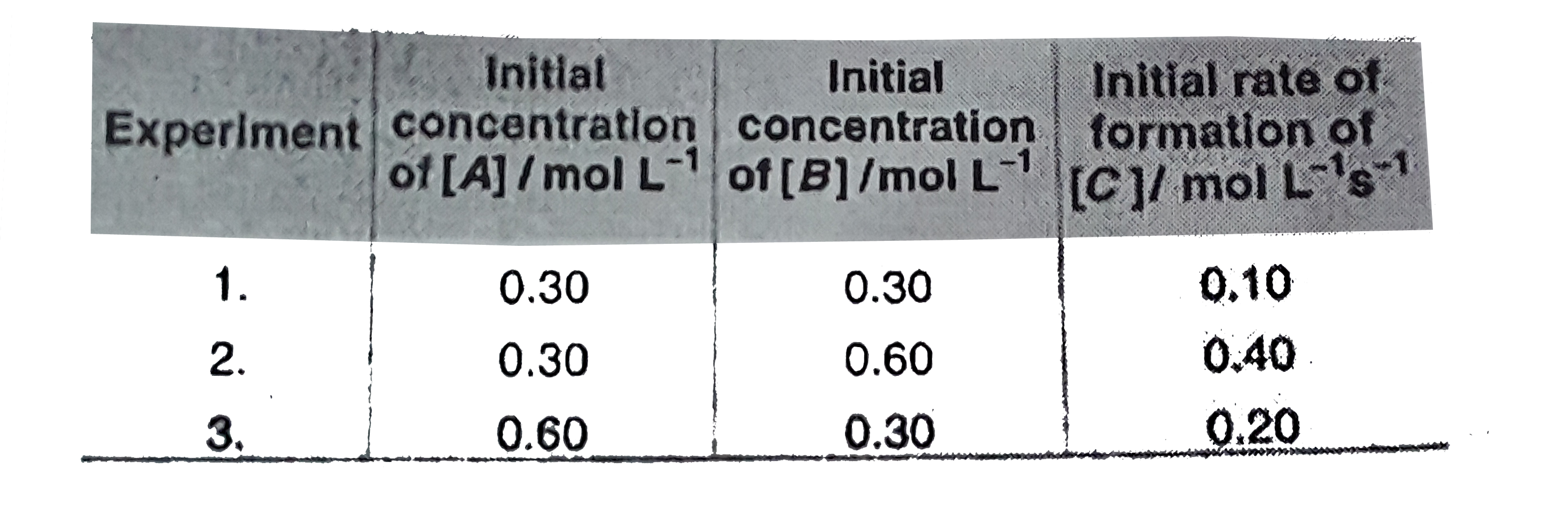Compounds 'A' and 'B' react according to the following chemical equation
A(g)+2B(g)→2C(g)
Concentration of either 'A' or 'B' were changed keeping the concentrations of one of the reactants constant and rates were measured as a function of initial concentration. Following results were obtained. Choose the correct option for the rate of equations for this reaction.

Rate of = k[A]2[B]
Rate = k[A][B]2
Rate = k[A][B]
Rate = k[A]2[B]−
The correct Answer is:B
Topper's Solved these Questions
- CHEMICAL KINETICSBOOK - DINESH PUBLICATIONCHAPTER - CHEMICAL KINETICSEXERCISE - Multiple type questions
4 Videos
- CHEMICAL KINETICSBOOK - DINESH PUBLICATIONCHAPTER - CHEMICAL KINETICSEXERCISE - Assertion Reason type questions
5 Videos
- CHEMICAL KINETICSBOOK - DINESH PUBLICATIONCHAPTER - CHEMICAL KINETICSEXERCISE - Higher order thinking skills (hots) question
18 Videos
- CHEMICAL BONDING AND MOLECULAR STRUCTUREBOOK - DINESH PUBLICATIONCHAPTER - CHEMICAL BONDING AND MOLECULAR STRUCTUREEXERCISE - Unit Test - 1
20 Videos
- CHEMICAL THERMODYNAMICS AND CHEMICAL ENERGETICS BOOK - DINESH PUBLICATIONCHAPTER - CHEMICAL THERMODYNAMICS AND CHEMICAL ENERGETICS EXERCISE - Exercise
507 Videos
Similar Questions
Compounds 'A' and 'B' react according to the following chemical equation.
A(g)→2B(g)→2C(g)
Concentration of either 'A' or 'B' were changed Keeping the concentration of one of the reactants constant and rates were measured as a function of initial concentration. Following result were obtained.
Choose the correct option for the rate equations for this reaction.

View SolutionCompounds 'A' and 'B' react according to the following chemical equation.
A(g)→2B(g)→2C(g)
Concentration of either 'A' or 'B' were changed Keeping the concentration of one of the reactants constant and rates were measured as a function of initial concentration. Following result were obtained.
Choose the correct option for the rate equations for this reaction.

View Solution
Knowledge Check
Compounds 'A' and 'B' react according to the following chemical equation.
A(g)→2B(g)→2C(g)
Concentration of either 'A' or 'B' were changed Keeping the concentration of one of the reactants constant and rates were measured as a function of initial concentration. Following result were obtained.
Choose the correct option for the rate equations for this reaction.
 ARate =k[A]2[B]BRate =k[A][B]2CRate =k[A][B]DRate =k[A]2[B]∘
ARate =k[A]2[B]BRate =k[A][B]2CRate =k[A][B]DRate =k[A]2[B]∘Compounds 'A' and 'B' react according to the following chemical equation.
A(g)→2B(g)→2C(g)
Concentration of either 'A' or 'B' were changed Keeping the concentration of one of the reactants constant and rates were measured as a function of initial concentration. Following result were obtained.
Choose the correct option for the rate equations for this reaction.
 ARate =k[A]2[B]BRate =k[A][B]2CRate =k[A][B]DRate =k[A]2[B]∘
ARate =k[A]2[B]BRate =k[A][B]2CRate =k[A][B]DRate =k[A]2[B]∘Compounds 'A' and 'B' react according to the following chemical equation.
A(g)→2B(g)→2C(g)
Concentration of either 'A' or 'B' were changed Keeping the concentration of one of the reactants constant and rates were measured as a function of initial concentration. Following result were obtained.
Choose the correct option for the rate equations for this reaction.
 ARate =k[A]2[B]BRate =k[A][B]2CRate =k[A][B]DRate =k[A]2[B]∘
ARate =k[A]2[B]BRate =k[A][B]2CRate =k[A][B]DRate =k[A]2[B]∘
Compounds A and B react according to the following chemical equation :
A(g)+2B(g)→2C(g)
Concentration of either A or B were changed keeping the concentrations of one of the reactant constants and rates were measured as a function of initial concentration, Following results were obtained.

Choose the correct option for the rate equations for this reaction.
View SolutionCompounds A and B react according to the following chemical equation :
A(g)+2B(g)→2C(g)
Concentration of either A or B were changed keeping the concentrations of one of the reactant constants and rates were measured as a function of initial concentration, Following results were obtained.

Choose the correct option for the rate equations for this reaction.
View SolutionCompound 'A' and B react according to the following chemical equation.
A(g)+2B(g)→2C(g)
Concentration of either A or B were changed keeping the concentrations of one of the reactants constant and rates were mesured as a function of initial concentration. Following results were obtained. Choose the correct option for the rate equations for this reaction.
ExperimentInitial concentration of[A]/molL−1Initial concentration of[B]molL−1Initial rate of formation of[c]/molL−1s−110.300.300.1020.300.600.4030.600.300.20
View SolutionCompound 'A' and B react according to the following chemical equation.
A(g)+2B(g)→2C(g)
Concentration of either A or B were changed keeping the concentrations of one of the reactants constant and rates were mesured as a function of initial concentration. Following results were obtained. Choose the correct option for the rate equations for this reaction.
ExperimentInitial concentration of[A]/molL−1Initial concentration of[B]molL−1Initial rate of formation of[c]/molL−1s−110.300.300.1020.300.600.4030.600.300.20
View SolutionRate law for the reaction A+2B→Cis found to be Rate =k[A][B] Concentration of reactant 'B' is doubled. Keeping the concentration of 'A' constant, the value of rate constant will be:
View Solution
